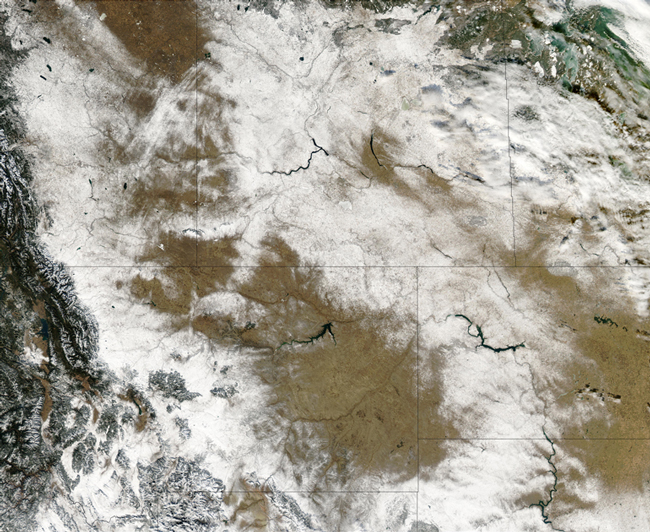
MODIS bands 1,4,3 RGB true color image of Canada and the Northern United States on the 1st of November 2002. Click on the image for a full size version of the 500m resolution image.
Early winter snows in the southwestern Canadian provinces and northwestern US Great Plains are featured on a grand scale in this true-color Aqua MODIS image acquired November 1, 2002. Snow does a very good job of highlighting land features in these true-color images where otherwise small bodies of water and varied land terrain might go unnoticed. For instance, the snow on the foothills of the Rocky Mountains, marching down the left side of the image, highlight steep hills and plunging valleys, while farther out in the plains small rivers and lakes become much more noticeable.
The brightness of the snow makes water bodies stand out in deep blue. In eastern Montana, there is Fort Peck Reservoir. In Saskatchewan, there are Lake Diefenbaker (west) and Last Mountain Lake (east), looking like little more than wide spots in a river. In North Dakota and South Dakota dams on the Missouri River create long, thin reservoirs. At upper right of the image, Lakes Winnipegosis and Winnipeg are taking on a cloudy green appearance, which suggests they are beginning to freeze.
The particular stretch of Rocky Mountains running along the Idaho/Montana border is the Bitterroot Range, mapped by Lewis and Clark on their 1804-1805 expedition. The range running from the British Columbia and Alberta border down into Montana is the Lewis Range, while the mountains running from south-central Montana into northern Wyoming is the Absaroka Range.
Clockwise from the upper left are Canada's British Columbia, Alberta, Saskatchewan, and Manitoba, and the United States' North Dakota, Minnesota, South Dakota, Wyoming, Montana, and Idaho.
Image and text courtesy of NASA's MODIS Land Rapid Response Team.